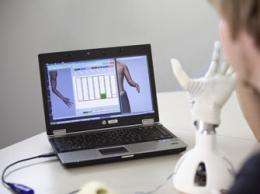Hi-tech prostheses: Personalized movement pattern recognition helps with control

Surgeons can now, thanks to bionic reconstructions, change the anatomy of patients so that high-tech prostheses can now replace the lost function of limbs very effectively. The control of these prostheses, which is currently linear, may soon be improved even further: with pattern recognition. In collaboration with Ottobock, this method is currently being tested and developed at the Christian Doppler Laboratory for the Restoration of Extremity Functions, which is being opened today (8th May) and which is being headed up by Oskar Aszmann from the Department of Plastic and Reconstructive Surgery at the University Department of Surgery at the MedUni Vienna, part of Vienna General Hospital.
“Pattern recognition is the latest development in bionic reconstruction. A special computer program, which we have developed in collaboration with Ottobock, will allow the prosthesis user’s highly personalised movement patterns to be stored. The prosthesis will then respond to these movement patterns,” explains Aszmann. “In other words, the prosthesis recognises when the patient wants to perform a certain movement and then carries it out.”
First, however, the computer has to “learn” to recognise the prosthesis user's intentions: the patients are connected to the computer via electrodes on the skin and prompted to carry out certain movements with their missing extremity, which triggers muscle contractions and impulses. This produces the activity pattern that can be interpreted as a movement that the user intends to make. The high-tech prosthesis can be customised on the basis of these patterns. Says Aszmann: “This system is currently undergoing experimental trials.” But within eighteen months, says the surgeon, we can expect “to be able to send patients home with these prostheses.”
Patrick Mayrhofer, Aszmann’s most famous patient so far, is also involved in the research work relating to pattern recognition. The young Austrian was fitted with a high-tech hand prosthesis in May 2011 at the MedUni Vienna. His story was a global media event – from interviews with the BBC to appearances on German TV shows. In January of this year, the British Ministry of Defence also approached Oskar Aszmann’s team for a bionic reconstruction. In a six-hour operation, a British soldier, who had lost his right arm whilst on duty in Afghanistan, was prepared for an arm prosthesis. The contact between the British Ministry of Defence and the scientists from Vienna highlights the global renown enjoyed by the MedUni Vienna and Vienna General Hospital as a centre for the restoration of function of the extremities.
The Christian Doppler Laboratory, set up specifically for this purpose, is set to further underpin the MedUni Vienna’s top position in the field. Says Aszmann: “Other research projects will lead to an intensive boost both in terms of technological development and clinical application.” Otto Bock Healthcare Products GmbH, the world market leader for prosthetics technology, is the CD Laboratory's enterprise partner.


















